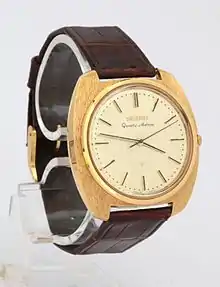Astron (wristwatch)
The Astron wristwatch, formally known as the Seiko Quartz-Astron 35SQ, was the world's first "quartz clock" wristwatch. It is now registered on the List of IEEE Milestones as a key advance in electrical engineering.
 | |
| Type | Quartz |
|---|---|
| Display | Analogue |
| Introduced | December 25, 1969 |

The Astron was unveiled in Tokyo on December 25, 1969, after ten years of research and development at Suwa Seikosha (currently named Seiko Epson), a manufacturing company of Seiko Group. Within one week 100 gold watches had been sold, at a retail price of 450,000 yen (US$1,250) each (at the time, equivalent to the price of a medium-sized car).[1] Essential elements included a Y-type quartz oscillator of 8192 cps, a hybrid integrated circuit, and a phase locked ultra-small stepping motor to turn its hands. According to Seiko, Astron was accurate to ±5 seconds per month or one minute per year, and its battery life was 1 year or longer.[2]
Anniversaries
In March 2010, at the Baselworld watch fair and trade show in Switzerland, Seiko previewed a limited edition new version and related designs of the original Astron watch, commemorating the fortieth anniversary in December 2009 of the debut of the Astron watch.[3]
References and footnotes
- "IEEE History Center: Electronic Quartz Wristwatch, 1969". IEEE.
- "Seiko Quartz Astron 35SQ December 1969: The quartz watch that revolutionized horological history". Seiko Epson.
- "The Watch That Changed Horological History" (PDF). Seiko Epson. Archived from the original (PDF) on March 31, 2010. (alternate version)
- The price of Toyota Corolla E10 was 432,000 yen (US$1,200) when it was released in 1966.
- "Seiko Quartz Astron 35SQ" (PDF). Seiko Epson Corporation. Retrieved 2018-01-22.
- "The new SEIKO Quartz Astron: A demonstration of SEIKO’s four decades of dedication to the perfection of the quartz watch", Archived 2013-03-19 at the Wayback Machine Seiko press release, March 18, 2010
Further reading
- "Seiko Quartz 35 SQ: The Seiko 35 SQ Astron was the first quartz watch on the market", Smithsonian Institution website.
- Thompson, Joe, "1969: Seiko’s Breakout Year", WatchTime Magazine, December 20, 2009